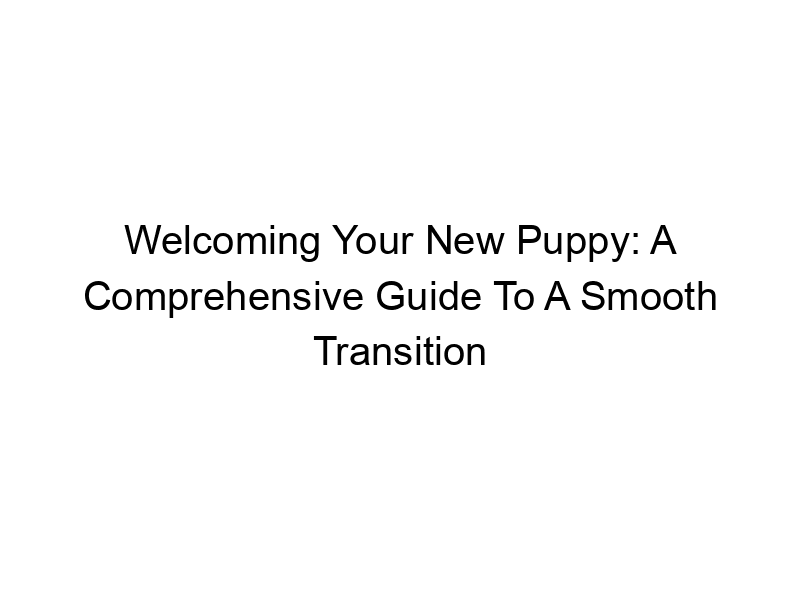Bringing a new puppy home is an exciting time, filled with boundless joy and the promise of unconditional love. However, introducing your furry friend to your home and family requires careful planning and patience to ensure a positive and stress-free experience for everyone. This comprehensive guide, How to Introduce a New Puppy to Your Home and Family, will walk you through each step, providing practical tips and advice to make the transition as smooth as possible. You’ll learn about creating a safe space, managing introductions to family members, and establishing a positive routine.
Creating a safe, quiet den for your puppy is crucial. This space should be comfortable, secure, and free from distractions. A crate, dog bed in a quiet corner, or even a designated room can work well.
Ensure the space has water, a comfortable bed, and some of your puppy’s favorite toys. This den serves as a retreat where your puppy can relax and feel secure. Think of it as their personal sanctuary.
Puppy-Proofing Your Home
Before your puppy arrives, thoroughly puppy-proof your home. This involves identifying and removing any potential hazards. Secure electrical cords, toxic substances (cleaning products, medications), small objects they could swallow, and anything fragile or valuable. Consider using baby gates to restrict access to certain areas until your puppy is fully house-trained. This proactive step prevents accidents and keeps your puppy safe.
Understanding Puppy Body Language
Learning to interpret your puppy’s body language is essential for understanding their emotional state. A relaxed puppy will typically have loose, wagging tails, soft eyes, and a playful demeanor. However, signs of stress or fear include tucked tails, whale eye (showing the whites of their eyes), yawning (even without being tired), and lip licking. Paying attention to these cues helps you adjust your approach and prevent potential issues.
Introducing Your Puppy to Your Home
The First Few Hours
The first few hours are critical. Let your puppy explore their safe space first, allowing them to adjust to their new surroundings at their own pace. Avoid overwhelming them with immediate introductions to family members or other pets. Let them settle in quietly, offering gentle reassurance as needed.
Gradual Exploration
Once your puppy has settled into their safe space, allow them to explore other parts of your home gradually. Supervise closely to prevent accidents and guide them gently. Avoid forcing them to explore if they seem hesitant. Remember, patience is key.
Managing Excitement
Family members, especially children, should be taught how to approach a puppy calmly and gently. Avoid loud noises or sudden movements, which can frighten a new puppy. Instead, encourage quiet, gentle interactions, allowing the puppy to sniff and approach on their own terms.
Introducing Your Puppy to Family Members
Individual Introductions
It’s best to introduce your puppy to family members individually at first, allowing for quieter, more controlled interactions. Let the family member sit or kneel down, allowing the puppy to approach them at their own pace. Positive reinforcement, such as gentle petting and praise, can help establish positive associations.
Children and Puppies
Children need to be educated on proper puppy interaction. Teach them to avoid startling the puppy, to pet them gently, and to never pull their tails or ears. Always supervise interactions between children and puppies to prevent accidents or injuries. Supervise, supervise, supervise.
Other Pets
Introducing a new puppy to existing pets requires a similar gradual approach. Initial introductions should be carefully managed, with the pets separated by a barrier, allowing them to sniff each other under the door or through a gate. Only allow face-to-face meetings when both animals seem relaxed and calm. Never leave them unsupervised until the pets are confident in each other’s presence.
Establishing a Positive Routine
House Training
House training is a crucial aspect of puppy integration. Consistency and positive reinforcement are essential. Establish a regular potty schedule, taking your puppy outside frequently (every hour for puppies under four months). Reward them immediately for eliminating outside with praise and treats. Clean up accidents thoroughly, avoiding harsh punishments.
Feeding and Hydration
Establish a regular feeding schedule. Provide fresh water at all times. Avoid free-feeding; instead, provide scheduled meals in their designated feeding area. This helps regulate their digestion and establishes structure.
Socialization
Proper socialization is vital for a well-adjusted dog. Start slowly, introducing your puppy to different sights, sounds, and environments. Consider puppy classes, which provide opportunities to socialize in a safe and controlled setting. Introduce your puppy to friendly, well-socialized dogs, but always supervise closely.
Addressing Potential Challenges
Separation Anxiety
Some puppies experience separation anxiety when left alone. Desensitization and counter-conditioning can help. Gradually increase the time spent alone, rewarding calm behavior when you’re away. Consider leaving a comforting item, such as a blanket or a stuffed toy, that smells like you.
Chewing
Chewing is a natural puppy behavior. Provide plenty of appropriate chew toys to redirect their chewing behavior. Make sure your home is adequately puppy-proofed to prevent destructive chewing.
Aggression
Puppy aggression can stem from fear, insecurity, or lack of socialization. Consult a certified professional dog trainer or veterinarian behaviorist if you notice signs of aggression. Early intervention is vital.
Choosing the Right Resources
Selecting a Veterinarian
Finding a trusted veterinarian is essential. Your veterinarian can provide vaccinations, guidance on health care, and address any health concerns. Regular check-ups are vital.
Utilizing Professional Dog Trainers
Professional dog trainers can help address behavioral issues and teach you effective training techniques. Look for certified trainers who use positive reinforcement methods.
Accessing Online Resources
Numerous reputable online resources offer valuable information and support for new puppy owners. Reliable websites and forums offer advice, training tips, and information on puppy care. Always double-check sources for accuracy and credibility.
The Long-Term Benefits of Proper Introduction
Building a Strong Bond
A smooth introduction builds a strong, trusting bond between you and your puppy. This bond will form the foundation for a lifetime of companionship and mutual love.
Preventing Behavioral Issues
Proper introduction and training can prevent many common behavioral issues, such as aggression, separation anxiety, and destructive chewing.
Ensuring a Happy, Healthy Puppy
A well-adjusted puppy will be more likely to be a happy and healthy companion. They’ll be confident, well-socialized, and capable of thriving in their new home.
Frequently Asked Questions
What are the common mistakes people make when introducing a new puppy?
Common mistakes include rushing the introduction process, failing to puppy-proof the home adequately, inconsistent training, neglecting socialization, and not understanding puppy body language. These mistakes can lead to behavioral issues and a strained relationship between the owner and the puppy.
How can I help my existing pets adjust to a new puppy?
Gradual introductions are essential. Keep pets separated initially, allowing them to sniff each other under a door or through a gate before face-to-face meetings. Positive reinforcement, calm demeanor, and supervision are vital throughout the process.
What if my puppy is exhibiting excessive fear or anxiety?
Consult with a veterinarian or certified professional dog trainer. They can assess the situation and recommend appropriate strategies to manage the anxiety, such as desensitization, counter-conditioning, or medication.
How long does it take for a puppy to adjust to a new home?
The adjustment period varies, but most puppies settle within a few weeks. Some may take longer, depending on their age, temperament, and prior experiences. Patience and consistent care are vital throughout this process.
My children are very excited about the puppy; how can I help them behave appropriately?
Teach children how to approach and interact with a puppy gently. Explain the importance of calmness, slow movements, and avoiding startling or overwhelming the puppy. Always supervise interactions and enforce rules for appropriate handling.
What are the signs of a stressed puppy?
Signs of a stressed puppy include tucked tail, whale eye (showing the whites of their eyes), yawning (even if not tired), lip licking, panting, trembling, and avoidance. If you notice these signs, give your puppy space and time to calm down.
Should I crate train my puppy?
Crate training offers many benefits, including providing a safe and secure space, aiding housetraining, and preventing destructive behavior. However, it’s crucial to introduce the crate positively, making it a happy, comfortable place for your puppy.
Final Thoughts
Bringing a new puppy home is a significant event, requiring careful planning and consistent effort. By following the steps outlined in this guide, you can create a positive and stress-free transition for your new furry friend. Remember, patience, consistency, and a lot of love are essential ingredients for building a strong bond and ensuring a happy life together. Creating a safe, enriching environment, understanding your puppy’s needs, and providing consistent training and socialization are vital for establishing a harmonious home life. With dedicated effort and love, you will welcome your new companion into your home and heart, forming a beautiful and lasting bond. Take the time to implement the strategies mentioned above, and enjoy the journey of welcoming your furry family member into your lives. Remember, this is a long-term commitment, and with patience and dedication, both you and your new puppy will thrive.




